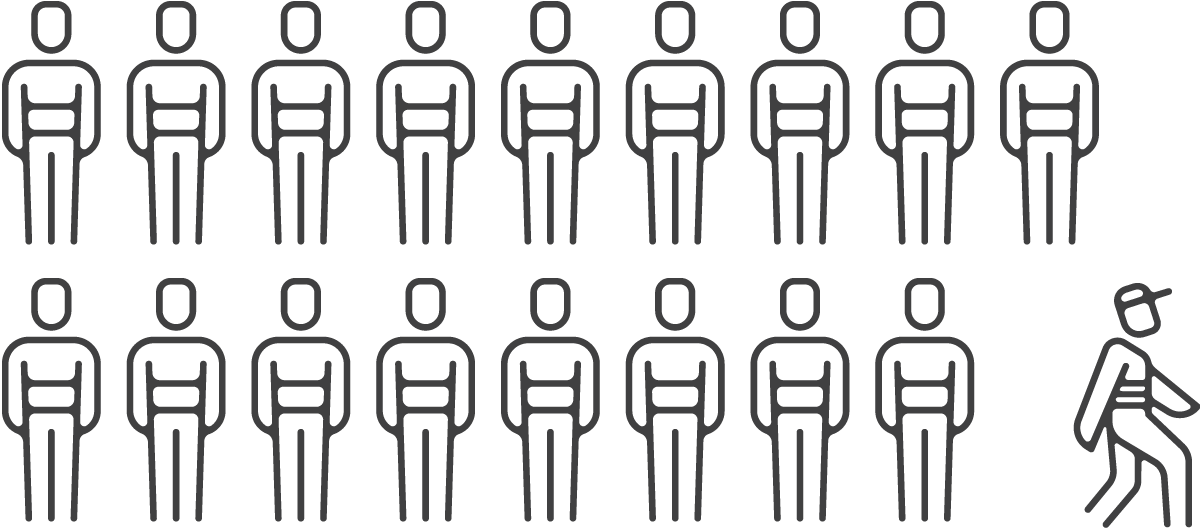Your audience is made of humans, not demographics.
When it comes to marketing, many businesses try to understand their market by reducing it down to demographics. In today’s market, this is not enough.
Our world has plenty of data. So much so that when you set up an ad campaign, you can target an audience based on salary, brands they like, marriage status, or if they might be expecting a child soon. This is in thanks to behavioral insights that massive platforms (like Facebook, Google, etc) have scraped from users. Not to discount all of the data, but reducing your ideal audience to specific attributes about their life can lead your business down the wrong path.
Don’t get me wrong, I love data. I love even more the science of human behavior. However, brands are about trust and trust is a very personal element. The mountains of data can be a useful tool to supplement your marketing, but just focusing on demographics will leave you targeting 34-year-old white males who make a certain salary and live in a specific geographical location. Does that sound personal?
Data is about numbers. Its core purpose is to reduce everything it devours into numbers. With numbers, it is able to produce ranges, averages, trends, and other stats. These are seemingly useful and look nice when portrayed on a graph, however, stats can be misleading and hide certain information or behavioral conditions that undermine the conclusion of the specific stat. (A great book on this is Risk Savvy) Does data seem like the right tool to base all of your marketing on? To reduce your audience to specific numbers and sell to these numbers? As data should, it washes the audience clean of all personality, biases, and preferences. It limits your insight and gives you a single human duplicated by X amount to determine a demographic.
Dem•o•graph•ic | noun: a particular sector of a population
Data is generally based on massive swabs of population, hence the term “big data” that has dominated Silicone Valley (and America) for the last 2 decades. When you consider the raw amount of information a data machine intakes, it makes sense that it focuses on just the numbers and spits out broad strokes about particular sectors of the population.
This “works” for some marketing, especially when social and search were newer technologies and a business was playing the Law of Numbers. However, after time spent in the markets, this demographic marketing has many consumers tired of it. The marketing now feels no different than voting polls or massive nationwide polls about topics — ultimately reducing very complex topics and decisions down to “yes or no”, “blue or red”, “right or left”,etc. You see my point in that data-infused marketing creates demographics that are strictly binary. Binary is how computers talk and understand (1=YES/ON 0=NO/OFF) so it seems impractical to apply this to humans who are not binary or even rational for that matter.
Humans are emotional. Data is binary and rational. These are complete polar-opposites, yet the business world is convinced that demographics are crucial to their brand and marketing. Economists have had to learn this the hard way in the last few decades as many of their models broke due to their assumption that humans are rational creatures. Wrong.
The psychology behind humans is far more important. It answers the irrationality. It creates a method to madness. Psychographics focus on personality, preferences, and emotional states. It’s a look at the human and not the number the human is — but the person they are.
A visual example of this is like Apple’s famous 1984 ad, the demographic being the robotic clones who all look the same and the psychographic being the Apple advocate. The one who is different, who stands out, who Thinks Different. It’s a mindset. A lifestyle. An emotional state that bucks against the bland, broad stroke of PC users. It’s exactly why this ad focused on liberating and it was such an effective ad because it snapped the audience out of their daze by having stories and emotions.
When you limit your audience to just demographics, you limit your effectiveness as a brand. You limit the desire of your audience which then limits the possible perceived value they see in your business’ brand and what you offer.

To market your brand to demographics is to neglect the human you’re trying to reach. Your communication is deprived of any emotion and treats the human like a number, not a person. It’s neither emotional or personal, it comes across cold. Or even worse is that it comes across just like every other business who markets this way.
Now I must warn you… marketing a brand based on demographics is easy. Like I said, ad campaigns can be set up just by clicking on certain attributes. There’s little risk because it feels like you are doing something — you are marketing… right? It’s easy, cookie cutter and looks good on a report in a graph.
Do you think Apple’s 1984 ad was easy? Do you think it was risky? Yes, it certainly was. Steve Jobs almost lost his position from the board due to it. It costs too much, wasn’t like the rest of the competition, and was unique. It had story and emotion. It was different and took immense effort to produce and even get approval.
Marketing a brand to humans and treating them like the persons they are is much more difficult and carries more risk. It cannot scale as easy and takes much more effort. The good news is that the reward is exponentially better than the alternative. In the short term as well as the long term. Your audience is made of humans, not demographics. Start marketing like it.

